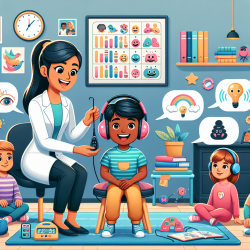Introduction
In the realm of speech-language pathology, making data-driven decisions is paramount to achieving the best outcomes for children. The research article "Management of Diffuse Low-Grade Glioma: The Renaissance of Robust Evidence" offers valuable insights that can be translated into the field of speech therapy. This blog will explore how practitioners can leverage the outcomes of this research to enhance their skills and encourage further research.
Understanding the Research
The article discusses the paradigm shift in the surgical management of diffuse low-grade gliomas (DLGGs) towards maximal safe resection (MSR). Despite the lack of high-quality randomized-controlled trials (RCTs), extensive observational data supports this transition. The research emphasizes the importance of integrating molecular, genetic, and imaging data to develop personalized care algorithms.
Applying Research Insights to Speech Therapy
While the context of DLGGs may seem distant from speech therapy, the underlying principles of data integration and personalized care are highly relevant. Here are some actionable steps for speech therapists:
- Data Integration: Just as the research highlights the integration of molecular, genetic, and imaging data, speech therapists can integrate various data sources such as assessments, progress reports, and parental feedback to create a comprehensive understanding of a child's needs.
- Personalized Care: The shift towards personalized care in DLGG management can inspire speech therapists to tailor their interventions based on individual assessments. This could involve customizing therapy sessions to address specific speech and language challenges unique to each child.
- Utilizing Technology: The research discusses the potential of machine learning and artificial intelligence in analyzing large datasets. Speech therapists can leverage technology, such as speech analysis software, to monitor progress and adjust interventions in real-time.
- Collaboration: The multi-disciplinary approach in DLGG management can be mirrored in speech therapy by collaborating with other professionals, such as occupational therapists, educators, and parents, to ensure a holistic approach to a child's development.
Encouraging Further Research
The research underscores the importance of well-designed international prospective observational registries and the use of advanced computational techniques. Speech therapists can contribute to the field by:
- Participating in Research: Engaging in research studies and contributing data can help build a robust evidence base for speech therapy practices.
- Staying Informed: Keeping abreast of the latest research and advancements in related fields can provide new insights and techniques that can be applied to speech therapy.
- Advocating for RCTs: Just as the article calls for high-quality RCTs in DLGG management, speech therapists can advocate for more RCTs in speech therapy to establish evidence-based practices.
Conclusion
By drawing parallels between the management of DLGGs and speech therapy, practitioners can enhance their skills and improve outcomes for children. Integrating data, personalizing care, utilizing technology, and fostering collaboration are key strategies that can be adopted. Moreover, contributing to and advocating for further research will ensure that speech therapy continues to evolve and provide the best possible care for children.
To read the original research paper, please follow this link: Management of Diffuse Low-Grade Glioma: The Renaissance of Robust Evidence.










